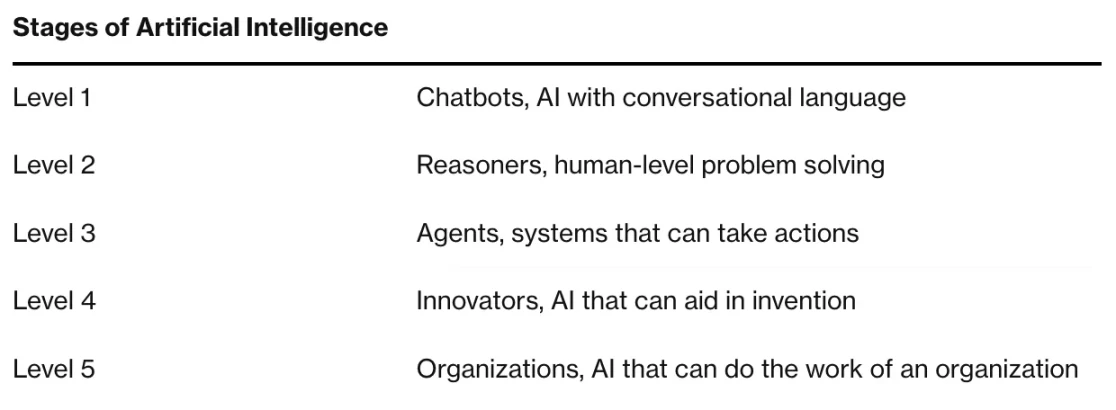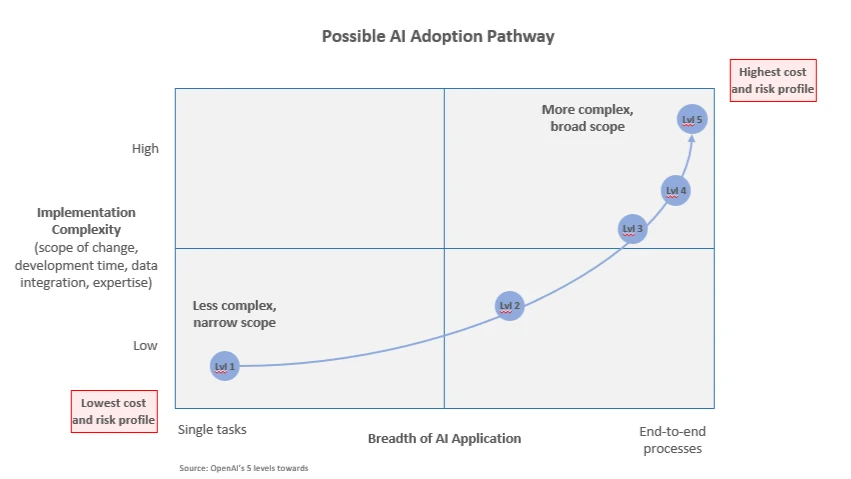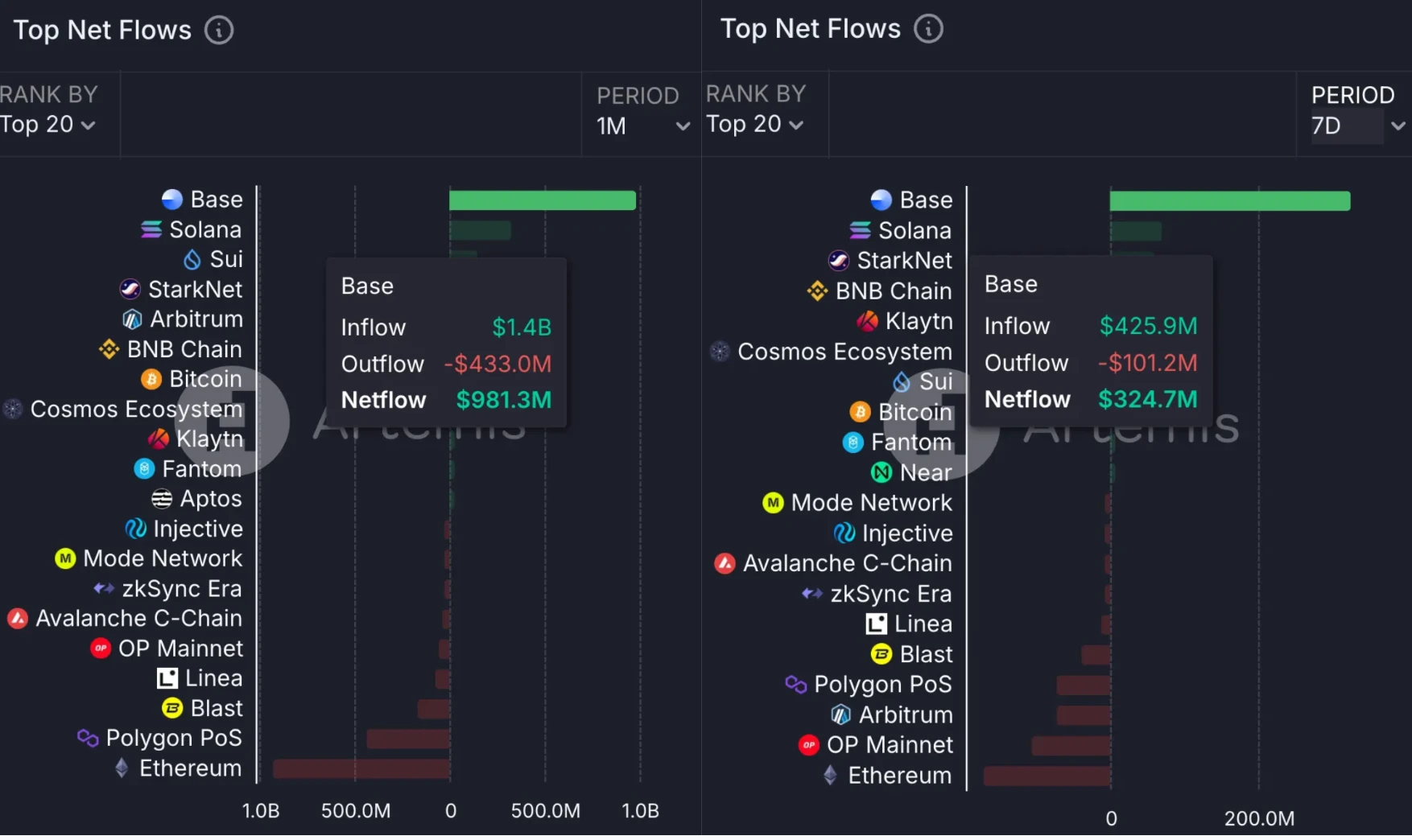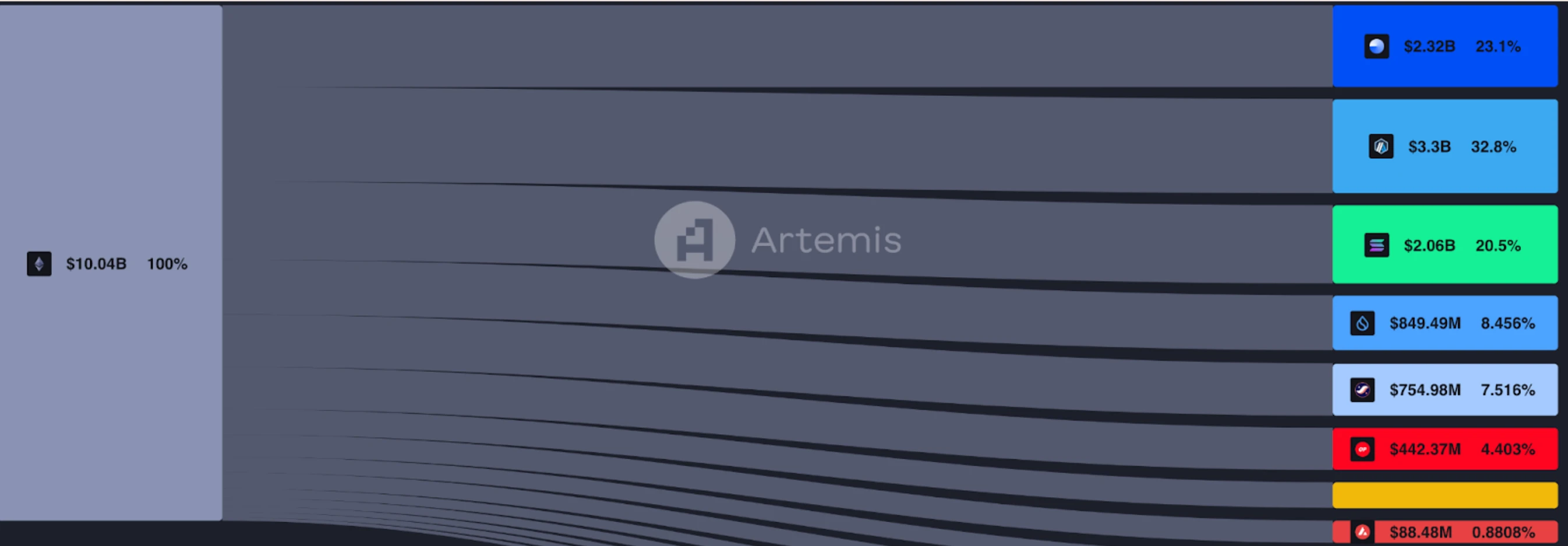Original author: Kevin, the Researcher at BlockBooster
The term AI agents comes from OpenAIs roadmap. Sam Altman divides the capabilities that AI should have into five parts, and the third step is the AI agent that we will frequently encounter in the next few years.
What AI agents can do is autonomous learning, decision-making, and task execution. Of course, according to the degree of intelligence and ability, Stuart Russell and Peter Norvig divide AI agents into five directions in the book Artificial Intelligence: A Modern Approach :
-
Simple Reflex Agents: React only to the current state.
-
Model-Based Reflex Agents: Historical states are considered during decision making.
-
Goal-Based Agents: Focus on planning and finding the best path to achieve a specific goal.
-
Utility-Based Agents: Aim to weigh benefits and risks to maximize utility.
-
Learning Agents: Continuously learn and improve through experience.
So what level are the AI agents currently in the market or in the industry at? What direction are they?
OpenAI o1 has reached Level 2 artificial intelligence. Personally, I think that the current AI agent in the industry is between Level 2 and Level 3, that is, Level 2.5. This does not mean that the agent in the industry has surpassed OpenAI. In fact, the web3 agent is still at the stage of GPT wrapper. So why is it Level 2.5? Because through the intervention of humans or programs, lets call it an intermediary, the combination of GPT wrapper and intermediary has formed a form that cannot withstand scrutiny, but has objective initiative. It is an extension of the application of the OpenAI model in a certain direction. In terms of what the agent can do, it is the most basic simple reflective agent. Some of these agents will consider historical states, but they need active input. Only by continuously feeding data can the agent complete learning. This is a passive model training method, far from reaching the state defined by Level 3. The latter three Goal-Based, Utility-Based, and Learning Agents have not yet entered the market. Therefore, I think that the current AI agent is still in its early stages, and is a fine-tuning of the Level 2 general LLM, and has not deviated from Level 2 in terms of architecture. So can the evolution to Level 3 be achieved by کرپٹو alone? Or do we need to wait for companies like OpenAI to develop it?
Why can discussing Base or Solana become the narrative center of AI agents?
Before discussing what can promote the birth of Level 3 agents in the industry, we should determine which ecosystem has the potential to become a fertile ground for AI agents. Is it Base? Or Solana?
To answer this question, lets review how AI has affected Web3 in the past two years. When OpenAI just released ChatGPT, the industrys protocols were still following the inertial thinking and quickly rushed into the infrastructure bubble. Among them, a large number of computing power/reasoning aggregation platforms emerged, and AI + DePIN infrastructure was also born. The common point between the two is that they have built a grand vision. This is not to say that grand visions are bad. In fact, agents can also build such visions, but in terms of implementation and user needs, such large infrastructure protocols are not well considered. Because the market demand they want to drag up is far from saturated in the traditional Internet industry, and user education and market education are not sufficient. Under the impact of the Memecoin craze, the empty AI infrastructure seems even more empty.
Since the infrastructure is too heavy and too large, why not make it lightweight? Agents derived from GPT wrappers are efficient and iterative in terms of startup and user reach. Lightweight agents have ample potential to create bubbles, and when the bubbles burst, fertile ground for new life will emerge.
Furthermore, in the current market environment, using agents and Memecoin to start a project can land the product in a very short time. Allowing users to directly get the experience of using it, in this process, the agent can also cleverly borrow the roadmap of Memecoin to grow the community to achieve rapid iteration of the product, and this iteration is low-cost and fast. Serious AI protocols no longer need to be bound by the heavy old consensus framework. Break the cage, go into battle lightly, bombard users with lightweight and high-speed iterations, and when market education and communication are fully carried out, then on this basis, add bricks and tiles to build the infrastructure of the grand vision. The lightweight agent is covered with the ambiguous veil of Memecoin. Community culture and fundamentals will no longer be a contradiction. A new asset development path is gradually emerging, and this may be a path chosen by new AI protocols in the future.
The above discussion answers the potential of AI agents to become the core narrative. Under the premise that AI agents can continue to grow rapidly, it is particularly important to choose the right ecosystem. Is it Base? Or Solana? Before answering this question, let’s take a look at the current status of serious agent protocols in the market.
First is Arweave/AO: PermaDAO mentioned: AO is designed using the Actor model, and each component is an independent agent that can operate in parallel, which is highly consistent with the application architecture driven by AI Agents. AI relies on three elements: models, algorithms, and computing power. AO can meet such high resource requirements. AO can independently allocate computing resources to each agent process, effectively eliminating computing performance bottlenecks.
In addition, Spectral is one of the few agent-based protocols, and its development direction is text-to-code and model reasoning.
Looking back at an agent token in the current market, we can find that these agents hardly use the chain infrastructure. This is a fact, because all models in the industry, including agents, are off-chain. Feeding data is off-chain, model training is not decentralized, and the output information is not on-chain. This is an objective fact, because the EVM chain does not support the combination of AI and smart contracts, and of course base and solana do not support it either. Next year, we can look forward to the introduction of ao, whether the model can be put on the chain and have a good performance. If ao fails, the model on the chain may have to wait until Ethereum is introduced many years later, at least not before 2030, or other public chains can realize the model on the chain, but if the architecture and historical resource reserves such as ao cannot be realized, the model on the chain may be more difficult for other public chains.
There are not many practical use cases for AI agent tokens at the moment. In fact, it is hard to tell the difference between ai agent coin and ai Memecoin on Base and Solana. Although agent tokens have no particular use, why do I think ai agent coin and ai Memecoin should not be confused? Because I think we are currently in the stage of creating an AI agent bubble.
Why is there discussion about Base wanting to compete with Solana for the dominant public chain position of AI agent?
Base attracted a lot of market attention in the first half of this bull market. In the competition for market share of Memecoin, Base had a brief and eye-catching performance, such as $BRETT and $DEGEN, but still lost to Solana. I think AI agent is the next direction for Base to compete, and it already has many advantages.
AI agents will accelerate the birth of bubbles and create chaos, but will eventually leave users and applications behind:
The birth and expansion of bubbles will attract the attention of the market, and this attention will undergo qualitative changes over time. What are the characteristics of such qualitative changes? As the market attention continues to increase, a series of user pain points and market gaps will be exposed. When the main contradictions cannot be coordinated, but the attention continues to increase, it is the moment of qualitative change. When the qualitative change is completed, the accumulated users and applications can undertake the grand vision. This is something that Memecoin cannot and does not intend to do, which is why I think that although agent and Memecoin are currently unclear, they should never be confused.
Before the qualitative change occurs, the bubble will give birth to a mess and various dramas. For example, the number of agents will increase exponentially, and thousands of agents will squeeze into the users sight. How to squeeze? Agents can access social media such as X and Farcaster to promote tokens themselves, and use various angles that degen likes and the information density unique to agents to promote tokens.
Then, the fast-iterating agent can complete the on-chain transaction, and a group of Vikings have entered the dark forest. The panel protocols on the market, the bots in the TG group, and the Dune panel will be invaded by agents. The indicators familiar to users will be manipulated by agents, such as transaction volume, number of addresses, chip distribution, and simulated dealer behavior. The on-chain data may need more professional cleaning to reflect its value, otherwise it will be deceived by agents, just like Vikings plundering your wealth.
If the market can reach this stage, the new era of AI agents will be halfway to success, because attention is value will allow agents to enter the mainstream. This potential comes from:
-
Strong distribution capabilities: Agents generate enough topics, such as Goat, and stable distribution paths can be replicated.
-
Ease of deployment: Agent deployment platforms will also explode, including Zerebro, vvaifu, Dolion, griffain and Virtual. Users do not need to know any code to build an agent, and the UX of agent deployment platforms will also be optimized in the competition.
-
Memecoin effect: In the startup phase, agent tokens do not have a suitable business model and the use cases of tokens are minimal. The Memecoin veil can quickly accumulate the community and keep the startup success rate efficient.
-
The upper limit is extremely high: OpenAIs Level 3 agent is still under development, and even giants cannot launch products quickly, so its market space must be huge. The lower limit of the agent is Memecoin, but the upper limit is an autonomous advanced intelligent agent.
-
Low market resistance: Agents led by Goat can build a large-scale audience. Agents are different from AI infrastructure, and users are not disgusted by them. When users are not disgusted, they are likely to start paying attention to it.
-
Potential incentives: The agent’s token use case has not yet been developed. If the agent introduces a points system and strengthens the incentives, it will be able to accumulate a large number of users.
-
Iteration potential: As mentioned above, agents are lightweight and can achieve rapid iteration of products. This objective iteration capability can create products and content that are increasingly attractive to users.
Therefore, AI agents can become the core narrative and a battleground for strategists.
Why does Base have the potential to compete with Solana?
With the strong support of Coinbase and North American capital, the Base ecosystem experienced explosive growth in 2024. In November, the capital inflow exceeded Solana, and it has significantly exceeded Solana in the past 7 days.
If ETH can continue to break through the ETH/BTC exchange rate next year, the spillover effect of ETH season will have a significant impact on Base. Currently, 23% of ETH outflows are to Base, and this figure is still rising.
AI agent Launchpad Mapping
Virtual
The V1 phase mainly focused on model training, data contribution, and interactive functions, while in the V2 phase, Virtual launched a token incubation platform for AI agents. The landmark update was fun.virtuals released in October.
Among them, LUNA has developed into an independent entity with independent identity and financial capabilities. In this process, LUNA and Coinbases roadmaps are aligned, and the latter provides powerful technical tools and support to help realize the implementation of AI agents on Base.
AI agent technology performs well in brand building, especially in the creation of cultural brands. Through AI agents, brands can interact with the community more efficiently. This includes simplifying interactive tasks and flexibly distributing rewards to improve user stickiness and brand awareness.
It is worth noting that all AI agent transactions only support the use of native Virtual tokens. Virtual tokens absorb the value capture of the entire ecosystem and become an important pillar of ecological development.
Virtual focuses on improving product functions, using AI tools to empower users and building a bridge between Web2 and Web3. It emphasizes use value rather than hype hot spots. Although its tool-type products are frequently used in actual applications, they lack the communication effect that cryptocurrencies usually have, which is also a shortcoming of the V1 stage.
Clanker
“Posting means issuing coins” lowers the threshold for token issuance and attracts a large number of users to try it out. People rush to @Clanker, which is similar to the operation of letting AI summarize video content in social media; but the difference is that here content publishing is directly converted into asset issuance.
How does Clanker work?
ٹوکنBot (Clanker) will deploy the Meme tokens on Base into the one-sided liquidity pool (LP), and the liquidity will be locked immediately. The token issuer will receive the following benefits:
-
0.25% of all swap fees.
-
1% of the total token supply (unlocked for one month).
Users can view the number of tokens deployed or create their own tokens through the clanker.world official website.
Unlike PumpFun, which issues tokens on Raydium through the bonding curve and charges a 1% transaction fee and a fixed fee of 2 SOL; Clanker does not adopt the bonding curve model, but charges a 1% fee as income through Uni v3 transactions.
AI Agent Layer
AI Agent Layer is a platform within the Base ecosystem that focuses on creating AI agents and Launchpads. It was officially launched on November 18. Before the launch of the platform, AIFUN Token was first issued on November 14 and has now been listed on exchanges such as MEXC and Gate. The current price is $0.09, with a market value of approximately $25 million.
Creator.bid
Creator.bid was originally an AI platform focusing on digital content monetization and ownership. In April this year, the platform completed a new round of financing.
On October 21, Creator.bid announced the official launch of the Base mainnet, realizing the function of creating and publishing AI agents with one click, providing content creators with new tools and profit models.
Simulacrum
Simulacrum is built on Empyreal. It transforms platforms such as Twitter, Farcaster, Reddit and TikTok into blockchain interaction layers. Users can perform on-chain operations such as token transactions or tip payments through simple social media posts.
Using technologies such as account abstraction, AI agents, intent-driven and language models, we can simplify complex blockchain backend operations and make DeFi easier for ordinary users to use.
vvaifu.fun
Similar to Pump.fun, users can easily create AI agents and their associated tokens. AI agents can be seamlessly integrated with social platforms such as Twitter, Telegram, and Discord to automate user interactions.
Dasha is an AI agent created by vvaifu.fun, with an independent Twitter account, Telegram channel and Discord community, all operated and managed by AI.
Top Hat
Top Hat can not only interact with users through text, but also understand and process image content. When a user sends a picture, the AI agent can understand the content of the picture and respond.
Griffain
With a trainable AI agent platform, Griffain has launched 1,000 trainable AI agents, demonstrating the future potential of smart contracts and automated transactions.
About BlockBooster
BlockBooster is an Asian Web3 venture studio backed by OKX Ventures and other top institutions. We are committed to becoming a trusted partner for outstanding entrepreneurs. Through strategic investment and in-depth incubation, we connect Web3 projects with the real world and help high-quality entrepreneurial projects grow.
Disclaimer: This article/blog is for informational purposes only and represents the personal opinions of the author and does not necessarily represent the views of BlockBooster. This article is not intended to provide: (i) investment advice or investment recommendations; (ii) an offer or solicitation to buy, sell or hold digital assets; or (iii) financial, accounting, legal or tax advice. Holding digital assets, including stablecoins and NFTs, carries a high degree of risk and may fluctuate in price or become worthless. You should carefully consider whether trading or holding digital assets is appropriate for you based on your financial situation. If you have questions about your specific situation, please consult your legal, tax or investment advisor. The information provided in this article (including market data and statistics, if any) is for general informational purposes only. Reasonable care has been taken in preparing these data and charts, but no responsibility is assumed for any factual errors or omissions expressed therein.
This article is sourced from the internet: Solana and Base, which ecosystem is more suitable for AI agent?
Original author: BitMEX BitMEX is pleased to announce the launch of a new address book whitelisting feature to improve the security and convenience of asset withdrawals for users on the platform. Functional Overview Add a new whitelist address at the network level to cover all assets under the network Prevent unauthorized withdrawals and ensure fund security Detailed Introduction What is the address book whitelist feature? The address book feature allows BitMEX users to store and name specific addresses for easier access when initiating withdrawal requests. Users can now convert their address book to a whitelist, allowing only addresses in the whitelist to make withdrawals. This means that addresses not listed in the whitelist will not be able to make withdrawals. Using the address book function, users can enjoy the following…











